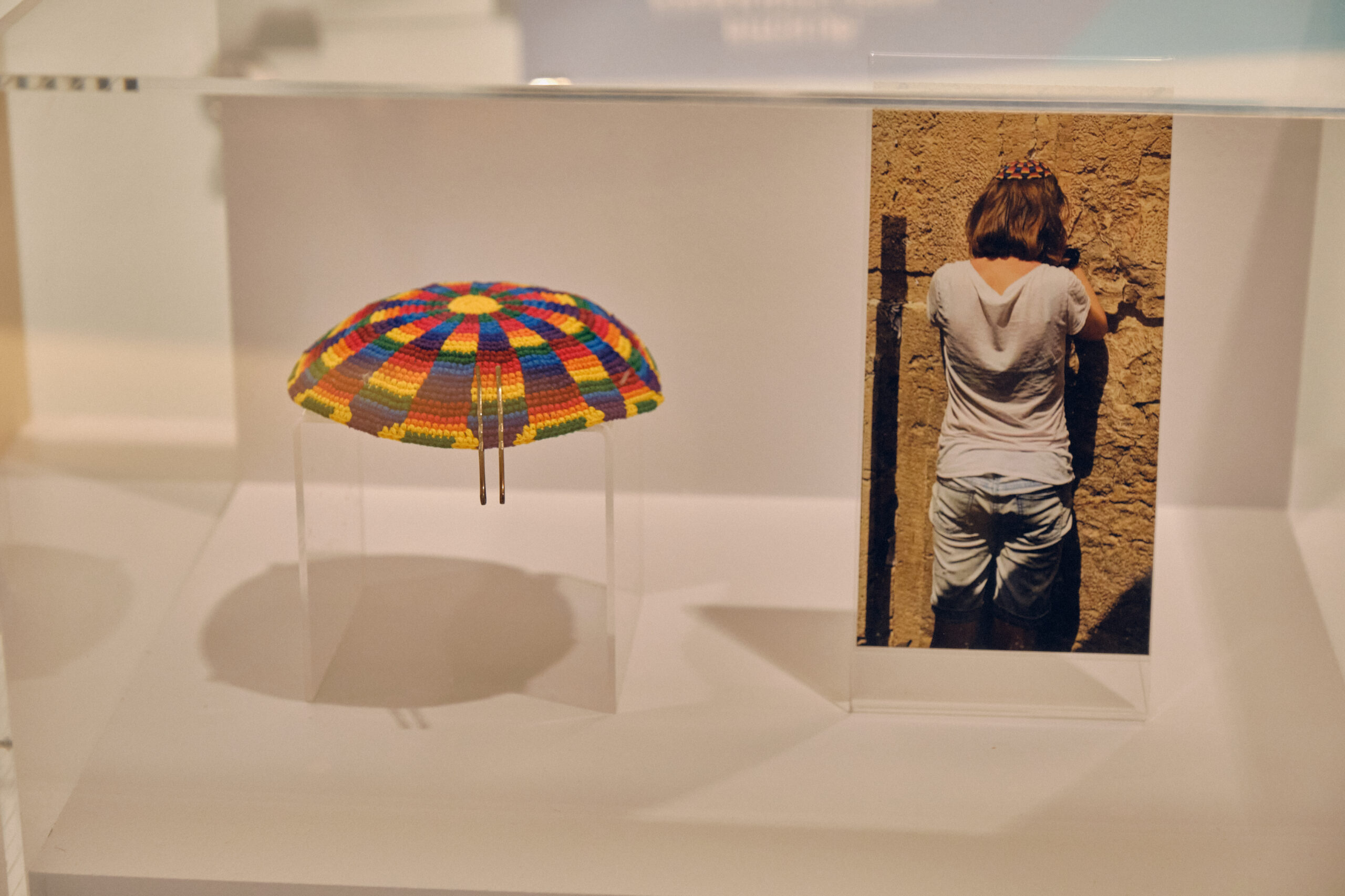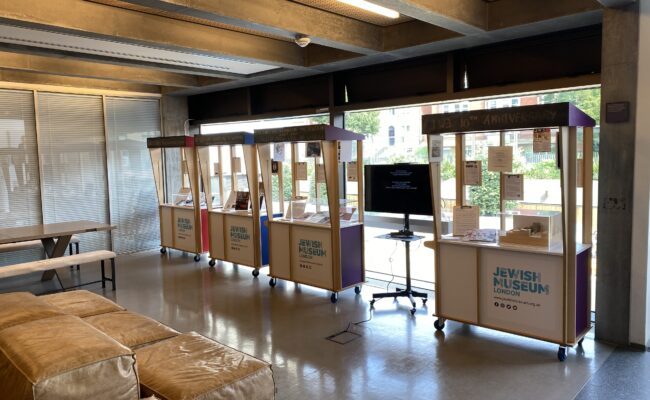A conversation between Claire Mead, Jewish Museum London & Mie Astrup Jensen, Hebrew and Jewish Studies, UCL

Museum: Tell us a bit about yourself and what you do.
Jensen: I’m Mie, and I’m originally from Denmark. Last year I moved to London during the pandemic to start at UCL, where I’m doing a PhD in sexuality & gender studies, and in Hebrew & Jewish studies. My PhD is funded by the ESRC and UKRI fund, and it’s called “Being queer and Jewish: a cross communal and cross national study of ethno religious experiences and devices”. I’m researching lesbian, bi and queer Jewish women’s lived experiences and practices and how they make sense to their life in England, and in Israel.
I’m really interested in how non heterosexual Jewish women negotiate their intimate relationships and their families, as well as their religious practices and beliefs, but also showcasing it across the Jewish spectrum. So, being infused with liberal, reform, conservative, orthodox and more cultural ethnic Jews to demonstrate that there’s not one way of being non heterosexual and Jewish, but it’s about showing all of these dynamics as well as the experiences that lesbian bi and queer women have.
The aim of my work is to really challenge the narrative that you have to choose between your identities; if you say that you’re LGBT and religious, some people might say you should choose – either be queer and stick to that, or you should be celibate, or you can be both but then you need to hide your sexuality. In spite of all of these processes that we see, you know we have LGBT rabbis, we have marriage equality…there is still that narrative that you need to choose between your identities.
For me, Jewishness is not just religious identity, it’s also historical, ethnic and cultural. One of the challenges that I have encountered is the question “why don’t you just leave your religious identity behind?” when people find out and they want to come out as being LGBT. Many people say yes, leave that religious stuff behind…which is often assuming that it’s more important, like your sexuality is more important than your religious identity, and often it’s not or they’re equal.
If people experience LGBTphobia in religious spaces or they experience religious phobia in LGBT spaces, there’s an increased risk of feeling more shame, depression, anxiety, suicidal ideation and identity fragmentation, so that you might be religious in religious spaces and gay in gay spaces but you can’t be gay and religious in both. But when people are able to successfully integrate these identities, they have a lot more self-acceptance and better mental health, and they report having a much healthier sexual and religious identity on top of this, which is one of the things that I really want to address: seeing that progress, and trying to find ways that you can integrate all of your identities without feeling like you have to choose.
Selecting an object
Museum: So, moving on to your object, we came to you because you had a really interesting object and link to your experiences and I was wondering if you tell me a little bit more about it, and what it represents for you?
Jensen: It’s a picture of me wearing a rainbow kippah at the Kotel in Jerusalem. For me the kippah is a very important Jewish symbol, as it was originally for men and then women started adopting it during second-wave feminism. The rainbow kippah to many can be seen as making a political statement and it’s a way to reclaim and reassert spiritual agency, a way to feel connected to Judaism, as well as creating this more egalitarian cultural legacy.
In 2019, I had just finished my undergraduate degree in sociology at the time and two weeks later, I went to Jerusalem. I knew that I was going to do my Master’s in Social research, and I thought okay I can make up my mind at that point. Then, a few weeks before I went to Jerusalem I suddenly saw on my social media that there would be Pride in Jerusalem when we were going. And so, we go to Jerusalem, and I went to the Kotel. And I started praying for some sort of a sign about what to do with my life and so my mum took that picture while I was praying for my whole revelation about my career. And wearing the kippah at the Kotel is a very beautiful symbol to me, because you have the symbol of wanting to create a very egalitarian cultural legacy on the ancient walls of the temple, and in many ways that’s like a beacon of hope and determination and commitment.
The following day, Pride was starting 10 meters from where we staying -It was so beautiful to be in one of the holiest cities in the world to all Abrahamic religions, and going to that Pride event and seeing religious symbols, Christians wearing a cross, we saw rainbow kippahs, we saw Muslims wearing Islamic symbols and so on. It was a really beautiful moment.
Then, the following day I went to Kabbalat Shabbat in Tel-Aviv, in this very small congregation and the rabbi openly talked about LGBT rights and marriage equality and LGBT families and it was the first time I’d really like explicitly heard someone talking about LGBT rights in that kind of way. And as I’m sitting there and I’m still wearing my rainbow kippah, that was like the moment that I decided to do what I do, like a whole revelation. I don’t know if it was that sign that I had prayed for or if everything just came together in this moment, but I got back, and I managed to get in touch with my two PhD supervisors, and they were very interested and super passionate about my work and UCL then allowed me to be supervised across disciplines and across departments and then the two schools basically created that entire thing for me because they really enjoy the project and then I won funding from the ESRC. So that’s the symbol of the rainbow kippah and that kind of moment where I’m standing at the Kotel is really the symbol of visibly being LGBT and having a religious identity, and my work, and the moment that I decided to do what I do.
One of the rabbis that I interviewed last year told me that Judaism has always had its rainbow of different versions of it. And that rainbow means a space in your home for everybody, but sometimes that home needs to be created, sometimes that rainbow needs space to be created. And I think that’s what a rainbow kippah in many ways symbolizes: that desire to create a home for not necessarily only LGBT people, but people who have been marginalized.
Museum: Thank you very much for sharing about this beautiful object – both the rainbow kippah and the picture of you at the Kotel, which has the added context of you donating that item to add to the Jewish Museum.
For more information visit: www.ucl.ac.uk/culture-online/ask-expert/meet-our-experts/mie-astrup-jensen
